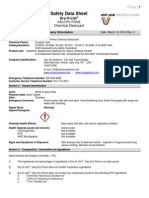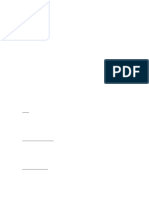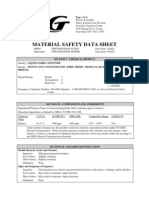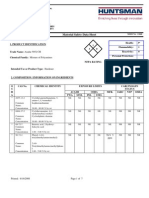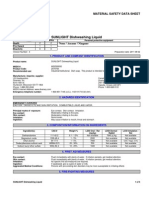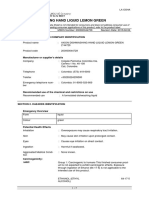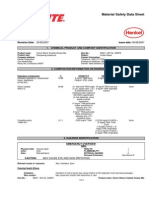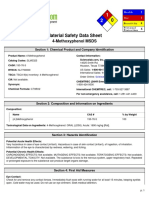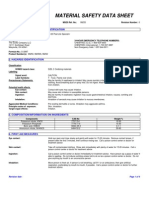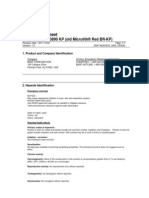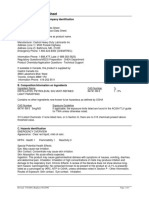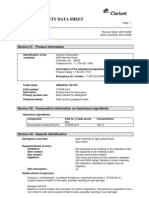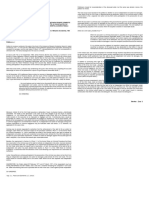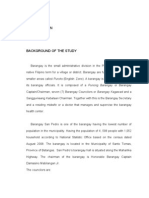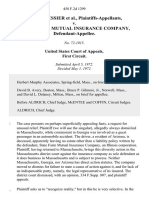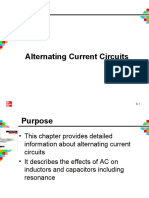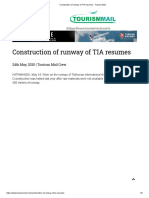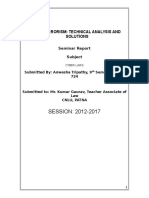0 ratings0% found this document useful (0 votes)
550 viewsPhyton 27 MSDS
Phyton 27 MSDS
Uploaded by
Bernardo UenoThis document summarizes the hazards of the product Phyton-27. It contains copper (II) sulfate, tannic acid, and picric acid. The product is a thick green/brown liquid with a pleasant odor. It is corrosive and can cause skin and eye irritation. In case of contact, rinse skin or eyes thoroughly with water. If swallowed, do not induce vomiting and seek medical help. Proper precautions like gloves and goggles should be used when handling. Spills should be contained and cleaned following regulatory guidelines.
Copyright:
Attribution Non-Commercial (BY-NC)
Available Formats
Download as PDF, TXT or read online from Scribd
Phyton 27 MSDS
Phyton 27 MSDS
Uploaded by
Bernardo Ueno0 ratings0% found this document useful (0 votes)
550 views2 pagesThis document summarizes the hazards of the product Phyton-27. It contains copper (II) sulfate, tannic acid, and picric acid. The product is a thick green/brown liquid with a pleasant odor. It is corrosive and can cause skin and eye irritation. In case of contact, rinse skin or eyes thoroughly with water. If swallowed, do not induce vomiting and seek medical help. Proper precautions like gloves and goggles should be used when handling. Spills should be contained and cleaned following regulatory guidelines.
Copyright
© Attribution Non-Commercial (BY-NC)
Available Formats
PDF, TXT or read online from Scribd
Share this document
Did you find this document useful?
Is this content inappropriate?
This document summarizes the hazards of the product Phyton-27. It contains copper (II) sulfate, tannic acid, and picric acid. The product is a thick green/brown liquid with a pleasant odor. It is corrosive and can cause skin and eye irritation. In case of contact, rinse skin or eyes thoroughly with water. If swallowed, do not induce vomiting and seek medical help. Proper precautions like gloves and goggles should be used when handling. Spills should be contained and cleaned following regulatory guidelines.
Copyright:
Attribution Non-Commercial (BY-NC)
Available Formats
Download as PDF, TXT or read online from Scribd
Download as pdf or txt
0 ratings0% found this document useful (0 votes)
550 views2 pagesPhyton 27 MSDS
Phyton 27 MSDS
Uploaded by
Bernardo UenoThis document summarizes the hazards of the product Phyton-27. It contains copper (II) sulfate, tannic acid, and picric acid. The product is a thick green/brown liquid with a pleasant odor. It is corrosive and can cause skin and eye irritation. In case of contact, rinse skin or eyes thoroughly with water. If swallowed, do not induce vomiting and seek medical help. Proper precautions like gloves and goggles should be used when handling. Spills should be contained and cleaned following regulatory guidelines.
Copyright:
Attribution Non-Commercial (BY-NC)
Available Formats
Download as PDF, TXT or read online from Scribd
Download as pdf or txt
You are on page 1of 2
Material Safety Data Sheet
May be used to comply with OSHAs Hazard Communication Standard 29 CFR 1910.1200. Standard must be consulted for specific requirements
IDENTITY (as used on label or list):
U.S. Department of Labor
Occupational Safety and Health Administration (Non Mandatory Form) Form Approved OMB No. 1218-0072
Note: Blank spaces are not permitted. If any item is not applicable, or no information is available, the space must be marked to indicate that.
PHYTON-27 Section I
Manufacturers Name: Phyton Corporation Address: 5608 International Parkway New Hope, MN 55428
Emergency Telephone Number: (ChemTrec) 800-424-9300 Telephone Number for Information: 763-432-4008 Date Prepared: June 10, 1994; Amended: April 19, 2010 Signature of Preparer (optional):
Section II-Hazardous Ingredients/Identity Information
Hazardous Components (specific chemical identity; common name(s).) CAS#: Name OSHA PEL TWA 00007758-98-7 Copper (II) Sulfate N/E N/E 00001401-55-4 Tannic Acid N/E N/E 00000088-89-1 Picric Acid .1 mg/m (skin) .1 mg/m (skin) Other Limits Recommended None None None % (optional) 21.36 1.08 1.25
Section III-Physical/Chemical Characteristics
Boiling Point Vapor Pressure (mm Hg) Vapor Density (Air = 1) Solubility in Water: Appearance and Odor: 96-103 C Specific Gravity (water = 1) N/D Melting Point N/D Evaporation Rate (butyl acetate =1) SOLUBLE Thick green/brown liquid with pleasant odor 1.200 N/A N/D
Section VI-Fire and Explosion Data
Flash Point (Degrees F): Method Used: Flammable Limits: LEL UEL > 141 Closed Cup N/A N/A N/A Extinguishing Media: Product is rated as non flammable but may burn when exposed to high temperatures. Firefighters and emergency responders should wear SCBA and use CO2 fire extinguishers. Special Fire Fighting Procedures: Use CO2 fire extinguishers and SCBA. NOx compounds may form under high temperatures. Unusual Fire and Explosion Hazards: Picrates may be explosive when subjected to extreme temperature.
Section V-Reactivity Data
Stability: Unstable Conditions to Avoid: Stable X None known Incompatibility (Materials to Avoid): None known Hazardous Decomposition or Byproducts: NOx Compounds may be generated Hazardous Polymerization: May Occur Conditions to Avoid: Will Not Occur X None known
Page 2
Phyton-27
Section VI - Health Hazard Data
Inhalation: Not Likely Health Hazards (Acute and Chronic): Route(s) of Entry: Skin: Ingestion: Yes Yes Corrosive: causes irreversible skin/eye damage Causes irritation to open wounds and mucous membranes pH = 4.7 IARC Monograph OSHA Regulated NOT LISTED NOT LISTED Eye and mucous membrane irritation. May be harmful if swallowed. Skin burns or sensitization may occur in some individuals. If ingested DO NOT induce vomiting. None known If in Eyes: Hold eye open and rinse slowly and gently with water for 15-20 minutes. Remove contact lenses, if present, after the first 5 minutes, then continue rinsing eye. Call a poison control center or doctor for treatment advice. If on Skin or Clothing: Take off contaminated clothing. Rinse skin immediately with plenty of water for 15-20 minutes. Call a poison control center or doctor for treatment advice. If Swallowed: Call a poison control center or doctor immediately for treatment advice. Drink promptly a large quantity of milk, egg white, gelatin solution, or, if these are unavailable, 1 or 2 glasses of water. Do not induce vomiting unless told to do so by a poison control center or doctor. Do not give anything by mouth to an unconscious person. Note to Physician: Skin symptoms may be similar to copper allergic reactions and can be treated similarly, including the use of steroidcontaining lotion. If swallowed, probable mucosal damage may contraindicate the use of gastric lavage.
Carcinogenicity:
NTP NOT LISTED Signs and Symptoms of Exposure:
Medical Conditions Aggravated by Exposure: Emergency and First Aid Procedures:
Section VII-Precautions for Safe Handling and Use
Steps to be Taken in Case Material is Released or Spilled: Waste Disposal Methods: Contact your state pesticide, environmental control agency, or the hazardous waste representative at your nearest EPA office for guidance. Plastic containers may be offered for recycling after triple rinsing. FOLLOW ALL LOCAL, STATE, AND FEDERAL REGULATIONS. THIS PRODUCT IS REGISTERED WITH THE EPA (REGISTRATION NO. 49538-2). THIS PRODUCT CONTAINS NO SECTION 313 (SARA) CHEMICALS. ALL OF THE INGREDIENTS LISTED AS HAZARDOUS ARE LISTED UNDER TSCA. SOME INGREDIENTS (COPPER (II) SULFATE AND PICRIC ACID) ARE LISTED UNDER THE COMMUNITY ACTION RIGHT TO KNOW STANDARD. Motor freight classification: AG INSECTICIDE, NOI ITEM #102 120 Non Hazardous. Harmonized Commodity Description & Coding System, HS:AG INSECT. 3808.10.0000-6 US EPA REGISTRATION NUMBER 49538-2 Non Corrosive under DOT standards IAW 49 CFR 172 & 173 Non flammable - Non combustible Do not ship or store below 45 degrees F or 8 degrees C. This Product is not expected to decompose, combust, or negatively react under normal circumstances.
Transportation Data:
Precautions to be Taken in Handling or Storing: Other Precautions:
Section VIII-Control Measures
Respiratory Protection (Specify Type): NONE SHOULD BE REQUIRED Ventilation: Local Exhaust: SHOULD NOT BE REQUIRED Special NONE Mechanical (General): RECOMMENDED Other NONE Protective Gloves: RECOMMENDED Eye Protection: GOGGLES Other Protective Clothing or Equipment: EYE WASH STATION OR EYE WASH APPARATUS Work/Hygienic Practices: Use appropriate protective equipment
You might also like
- PNP MC No 2021 027 Entitled Formulation Use and Adjudication of CIW 1Document25 pagesPNP MC No 2021 027 Entitled Formulation Use and Adjudication of CIW 1IMEG Mindanao67% (6)
- The Health & Safety Guide for Film, TV & Theater, Second EditionFrom EverandThe Health & Safety Guide for Film, TV & Theater, Second EditionRating: 4 out of 5 stars4/5 (1)
- PAO MSDS RevB (ATI)Document5 pagesPAO MSDS RevB (ATI)khlowNo ratings yet
- Taski D7 Msds - Free PDFDocument3 pagesTaski D7 Msds - Free PDFanushkasamantha0% (1)
- MSDS Sodium Bicarbonate MalanDocument7 pagesMSDS Sodium Bicarbonate Malandhono vandieselNo ratings yet
- MBK 3204SC LDPE Film FDA Direct Food Contact Tape MSDS 2014Document8 pagesMBK 3204SC LDPE Film FDA Direct Food Contact Tape MSDS 2014ShaikhRizwanNo ratings yet
- Zeromist - 01 U - MSDSDocument6 pagesZeromist - 01 U - MSDSLuuThiThuyDuongNo ratings yet
- Corn OilDocument5 pagesCorn OilRino Anugraha TriatmajaNo ratings yet
- MSDS Ken ToolDocument8 pagesMSDS Ken ToolTpereda 2014No ratings yet
- Material Safety Data Sheet: One Step MSDS No. 916Document4 pagesMaterial Safety Data Sheet: One Step MSDS No. 916Begert JamesNo ratings yet
- Pressure Indicator PasteDocument7 pagesPressure Indicator PasterochirrephttoNo ratings yet
- Dry o Lite Msds SheetDocument4 pagesDry o Lite Msds Sheettr0798100% (1)
- NOVADIP4250TCrev4 (MSDS)Document5 pagesNOVADIP4250TCrev4 (MSDS)John AtkinsNo ratings yet
- Naval JellyDocument4 pagesNaval JellyjohnsopranaNo ratings yet
- Cyani Ver 3 Cyanide Reagent For 10 ML SampleDocument15 pagesCyani Ver 3 Cyanide Reagent For 10 ML SampleRisha KhairunnisaNo ratings yet
- MSDS - Stanbio GlukosaDocument4 pagesMSDS - Stanbio GlukosaDoni Eka PrasetiyoNo ratings yet
- pzt-lead-zirconate-titanate-12626-81-2_sdsDocument9 pagespzt-lead-zirconate-titanate-12626-81-2_sdsAhmed WaelNo ratings yet
- Loctite Nickel High Purity MSDSDocument5 pagesLoctite Nickel High Purity MSDSmarciofelipessantosNo ratings yet
- Msds 100102 Silicone Platinum CatalystDocument6 pagesMsds 100102 Silicone Platinum CatalystLukman Nul HakimNo ratings yet
- ED - 13 - Supelco 37 Component FAME MixDocument8 pagesED - 13 - Supelco 37 Component FAME MixbenjanunezgNo ratings yet
- Liquid Downy Non ConcentratedDocument5 pagesLiquid Downy Non ConcentratedJoniel Rosal JayagNo ratings yet
- Loc Tite 545Document5 pagesLoc Tite 545Mark Evan SalutinNo ratings yet
- Olaplex InstructionsDocument5 pagesOlaplex InstructionsÍris Ueda Karpischek SchardtNo ratings yet
- Ci-25 - MSDSDocument4 pagesCi-25 - MSDSAtif Aslam100% (1)
- HH - 1454899 Citric AcidDocument5 pagesHH - 1454899 Citric Acidadel boukadoumNo ratings yet
- Aradur 5052 FispqDocument7 pagesAradur 5052 FispqNuno Cartageno CardosoNo ratings yet
- Cherne Smoke Fluid MSDSDocument4 pagesCherne Smoke Fluid MSDSPromagEnviro.comNo ratings yet
- CP-4601-46 MsdsDocument6 pagesCP-4601-46 MsdskapenziaNo ratings yet
- Material Safety Data SheetDocument7 pagesMaterial Safety Data SheetZahra AnnisaNo ratings yet
- Safety Data Sheet: Section 1. IdentificationDocument9 pagesSafety Data Sheet: Section 1. IdentificationYahya ArdianNo ratings yet
- JD Sunlight Liq DishDocument4 pagesJD Sunlight Liq DishmansuraquelNo ratings yet
- Huish 1Document4 pagesHuish 1hugogaunaNo ratings yet
- Axion Liq LimónDocument7 pagesAxion Liq Limónyenni viviana67% (3)
- CL Overlapping CompoundDocument4 pagesCL Overlapping CompoundMark Evan SalutinNo ratings yet
- MSDS Y-750Document7 pagesMSDS Y-750shivaenterprisesdelhi88No ratings yet
- MSDS Poly SugaBetaine L (16 Section)Document5 pagesMSDS Poly SugaBetaine L (16 Section)mndmattNo ratings yet
- Material Safety Data Sheet: Ampicillin Sodium Salt Section 1 - Chemical Product and Company IdentificationDocument5 pagesMaterial Safety Data Sheet: Ampicillin Sodium Salt Section 1 - Chemical Product and Company IdentificationbeletristicliteraturNo ratings yet
- Msds 4-MethoxyphenolDocument5 pagesMsds 4-MethoxyphenolSholekhah ArviyantiNo ratings yet
- 4015-Flocculant SDSDocument5 pages4015-Flocculant SDSAquasoul CoNo ratings yet
- Msds. 2-EaqDocument6 pagesMsds. 2-EaqNazuah Ushwatun HassanahNo ratings yet
- Oil Eater Degreaser Cleaner Kafko InternationalDocument3 pagesOil Eater Degreaser Cleaner Kafko InternationalstevgonNo ratings yet
- Coladet EQ 154Document6 pagesColadet EQ 154mndmattNo ratings yet
- Laundry Detergent MSDSDocument6 pagesLaundry Detergent MSDSVishal BarveNo ratings yet
- Msds Grafic HuDocument2 pagesMsds Grafic Huemmanuel.jandosNo ratings yet
- Safety Data Sheet: Per GHS Standard FormatDocument6 pagesSafety Data Sheet: Per GHS Standard FormatM.MuthumanickamNo ratings yet
- Msds Asam BorakDocument4 pagesMsds Asam BorakIman HaerudinNo ratings yet
- Safety Data Sheet According To (EC) No 1907/2006: TURCO 4181Document8 pagesSafety Data Sheet According To (EC) No 1907/2006: TURCO 4181Panneer SelvamNo ratings yet
- Liang Chi Industry Philippines, Inc. Hydralchem Material Safety Data SheetDocument6 pagesLiang Chi Industry Philippines, Inc. Hydralchem Material Safety Data SheetCNo ratings yet
- MSDS FDC Yellow No%6 Aluminum Lake 15-18Document6 pagesMSDS FDC Yellow No%6 Aluminum Lake 15-18Vanti_805No ratings yet
- WD40Document4 pagesWD40barisalmanNo ratings yet
- MSDS Prilled UreaDocument6 pagesMSDS Prilled UreaLutfi IsmailNo ratings yet
- 1624 MSDS PDFDocument3 pages1624 MSDS PDFMostofa RubalNo ratings yet
- Microlith Red 3890 KPDocument7 pagesMicrolith Red 3890 KPPablo Hernan NupieriNo ratings yet
- SMS ASTM 187 192 KrollsDocument5 pagesSMS ASTM 187 192 KrollsRavi TejaNo ratings yet
- Transynd Synthetic Trans FluidDocument4 pagesTransynd Synthetic Trans FluidWan SuhiroNo ratings yet
- Genapol UD 070Document7 pagesGenapol UD 070Amy ZahraNo ratings yet
- Isoflurane 2Document6 pagesIsoflurane 2Abi ZakiNo ratings yet
- Power CleanDocument2 pagesPower CleanMark Evan SalutinNo ratings yet
- Liquid Laundry Detergent - All VariantsDocument5 pagesLiquid Laundry Detergent - All VariantschjjonNo ratings yet
- DuracetalDocument3 pagesDuracetalPedro FreitasNo ratings yet
- REACH Compliance: The Great Challenge for Globally Acting EnterprisesFrom EverandREACH Compliance: The Great Challenge for Globally Acting EnterprisesNo ratings yet
- 7452 Fisa Tehnica PDFDocument2 pages7452 Fisa Tehnica PDFwilelectronicaNo ratings yet
- A.C. Dulalas & F.G. Zapatos Law Office For Petitioners. Rufino Abadies For Respondent Eligio AbamongaDocument2 pagesA.C. Dulalas & F.G. Zapatos Law Office For Petitioners. Rufino Abadies For Respondent Eligio AbamongaTrix BermosaNo ratings yet
- The Green Book: Another Spoon Fed Film About Racial: Reconciliation by Whites?Document7 pagesThe Green Book: Another Spoon Fed Film About Racial: Reconciliation by Whites?AnnNo ratings yet
- NN7299526047140 ETicketDocument2 pagesNN7299526047140 ETicketSourav RayNo ratings yet
- RFBT 1stpb Exam-5.21Document9 pagesRFBT 1stpb Exam-5.21Emmanuel TeoNo ratings yet
- Background of The Study-FinalDocument7 pagesBackground of The Study-FinalRalph Angelo Facundo86% (14)
- Aeroquip Performance PDFDocument67 pagesAeroquip Performance PDFJonni SchneiderNo ratings yet
- AACRADocument5 pagesAACRAmeghavichare786No ratings yet
- Final Prospectus 19-20Document21 pagesFinal Prospectus 19-20LovetrueNo ratings yet
- Stock To Watch:: Nifty ChartDocument3 pagesStock To Watch:: Nifty ChartbidyuttezuNo ratings yet
- Thomas Tessier v. State Farm Mutual Insurance Company, 458 F.2d 1299, 1st Cir. (1972)Document3 pagesThomas Tessier v. State Farm Mutual Insurance Company, 458 F.2d 1299, 1st Cir. (1972)Scribd Government DocsNo ratings yet
- UTGOP Lawsuit Over Count My VoteDocument42 pagesUTGOP Lawsuit Over Count My VoteRobert GehrkeNo ratings yet
- Handwriting Analysis Part 1Document27 pagesHandwriting Analysis Part 1Tubagus Donny SyafardanNo ratings yet
- Alih Vs Castro 151 SCRA 279Document2 pagesAlih Vs Castro 151 SCRA 279LIERA100% (1)
- Alternating Current CircuitsDocument43 pagesAlternating Current CircuitsEarl Patrick EugenioNo ratings yet
- Construction of Runway of TIA Resumes - Tourism MailDocument3 pagesConstruction of Runway of TIA Resumes - Tourism MailDinesh PoudelNo ratings yet
- Martin Armstrong Biography May 2011Document63 pagesMartin Armstrong Biography May 2011Kris100% (1)
- Agency, Trust & Partnership Reviewer - 1810-1836 (Cambri Notes)Document6 pagesAgency, Trust & Partnership Reviewer - 1810-1836 (Cambri Notes)Arvin Figueroa100% (2)
- Anwesha CyberDocument29 pagesAnwesha CyberAnwesha TripathyNo ratings yet
- Maine Unwinding Data LetterDocument4 pagesMaine Unwinding Data LetterWGME CBS 13No ratings yet
- AP Business Rules 2018 PDFDocument238 pagesAP Business Rules 2018 PDFbhaskar rao gopisettiNo ratings yet
- Philippine Military History - ROTC - Activity #2Document10 pagesPhilippine Military History - ROTC - Activity #2Dark SideNo ratings yet
- B. 2. Diampoc Vs Buenaventura DDocument2 pagesB. 2. Diampoc Vs Buenaventura DJuris DoctorNo ratings yet
- The Philosophes and Public Education PDFDocument16 pagesThe Philosophes and Public Education PDFenanodumbiNo ratings yet
- Engagement LetterDocument4 pagesEngagement LetterJessicaGonzalesNo ratings yet
- Google Chrome Disables Domain Relaxation Starting M109 - SAP For MeDocument1 pageGoogle Chrome Disables Domain Relaxation Starting M109 - SAP For MePhildarPhunsiNo ratings yet
- SS 2 CIVIC QuestionsDocument16 pagesSS 2 CIVIC QuestionsSamuel Sunday100% (1)
- AAMAKA HOUME CO. L.L.C VAT Registration Certificate On 22Document1 pageAAMAKA HOUME CO. L.L.C VAT Registration Certificate On 224jm2924w7kNo ratings yet
- Olivieretal. 2019 Racism PDFDocument11 pagesOlivieretal. 2019 Racism PDFCostel Maryan DalbanNo ratings yet











